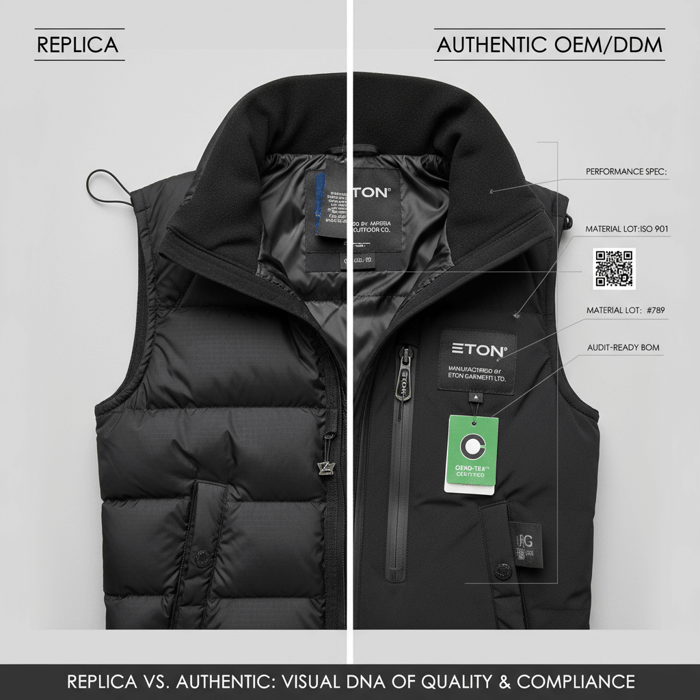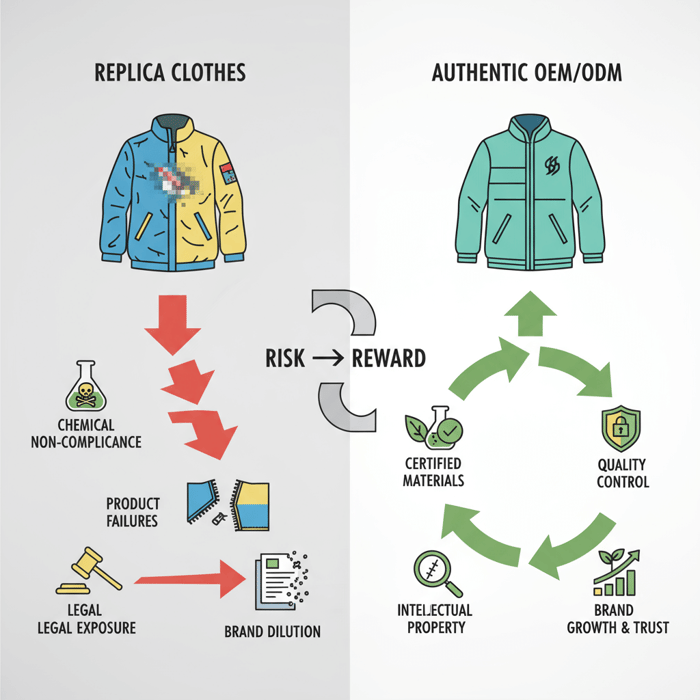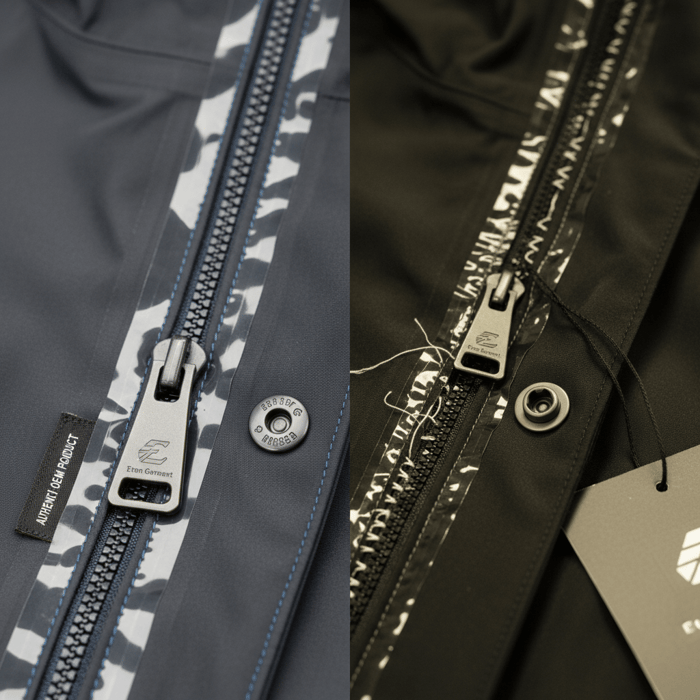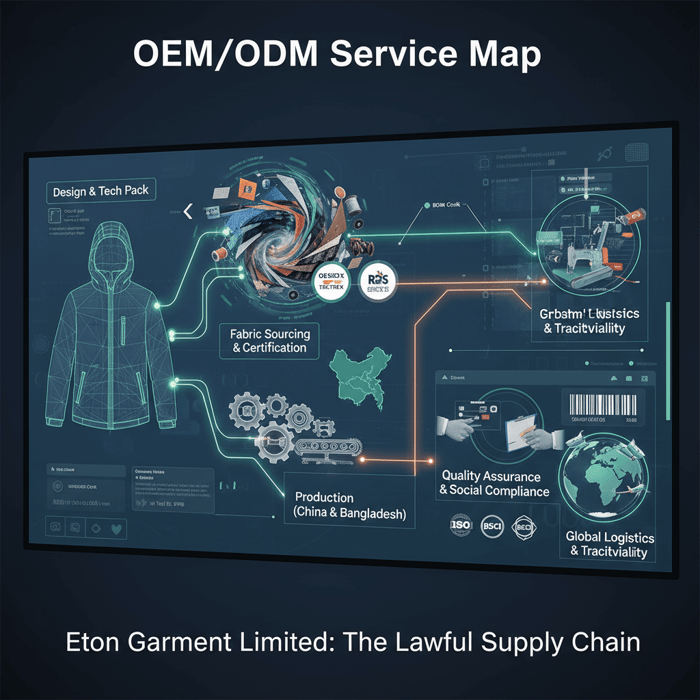Replica Clothes vs OEM/ODM: Legal Risks, Compliance, and How Brands Win with a China Clothing Manufacturer

 Mr. Eton Yip | 32+ Year Garment Manufacturing Expert & Founder of Eton Garment
Mr. Eton Yip | 32+ Year Garment Manufacturing Expert & Founder of Eton Garment
October 28th, 2025
11 minute read
Replica Clothes vs OEM/ODM: Legal Risks, Compliance, and How Brands Win with a China Clothing Manufacturer
Replica clothes attract clicks and short-term sales, but they carry legal exposure and brand damage. For US & EU fashion labels, partnering with a compliant China Clothing Manufacturer for OEM/ODM delivers lawful, traceable quality and speed. This guide maps the legal realities, risk controls, and a practical path to outperform the replica market—grounded in outerwear manufacturing experience.
What “replica clothes” mean—and how they differ from counterfeits, dupes, and authentic OEM/ODM
Replica clothes typically mimic branded designs and marks to ride on another label’s IP. Counterfeits copy trademarks and logos, deceiving consumers and violating law. Dupes echo style cues without overt trademark use. Authentic OEM/ODM is lawful manufacturing under contract, full IP rights, and traceable compliance.
Replica clothes are marketed to look and feel like a known brand’s product. Counterfeit goods cross a legal line by using registered marks, logos, or trade dress that confuses consumers. “Dupes” usually avoid the exact logo but can still infringe design rights or trade dress if they create likely confusion or dilute distinctiveness. Authentic OEM/ODM follows signed development agreements, documented bill of materials, and manufacturer declarations that keep design ownership clear and enforceable.
For apparel, confusion often stems from silhouettes, signature details, graphics, colorways, and packaging. In practice, replica clothes often mirror technical features—stitch layouts, pocket placement, label styling—that together form protectable trade dress. OEM/ODM development uses tech packs, fit blocks, performance specs, and test reports that tie every feature back to a brand’s original roadmap and lawful IP filings. [CITE: “Trade dress definition and case examples by a recognized IP law journal”] [MENTION: “U.S. IP attorney Mark McKenna’s analysis on trade dress”] [INTERNAL LINK: Our foundational guide on ‘OEM vs ODM in apparel’]

US & EU legality: trademarks, design rights, and enforcement that targets replica clothes
In the US, counterfeiting violates the Lanham Act; Customs (CBP) targets imports; penalties include fines, seizure, and criminal charges. In the EU, EUIPO registers trademarks and designs; authorities enforce at borders and in-market; penalties include confiscation, damages, and prosecution.
United States: Trademark infringement and counterfeiting are enforced under the Lanham Act, with civil actions for infringement and dilution, statutory damages, and enhanced remedies for willful conduct. US Customs and Border Protection (CBP) and Homeland Security Investigations (HSI) seize counterfeit shipments, pursue criminal cases, and coordinate with rights holders. Apparel also faces FTC labeling rules, CPSIA for children’s products, and state laws such as California Proposition 65. [CITE: “CBP annual intellectual property rights enforcement report”] [MENTION: “US CBP IPR Center”] [INTERNAL LINK: Our guide to ‘US import compliance for outerwear’]
European Union: EUIPO manages EU trademarks (EUTM) and registered designs; the Unregistered Community Design (UCD) can protect certain design elements for three years. National authorities and OLAF coordinate border seizures and in-market enforcement. Apparel must meet REACH chemical limits and the EU Product Safety rules, which replicas rarely document. Civil remedies include injunctions, damages, and destruction orders; criminal penalties apply in severe cases. [CITE: “EUIPO 2023 report on counterfeit impact in apparel”] [MENTION: “EUIPO Observatory on Intellectual Property Infringements”]
| Region | Primary Legal Basis | Enforcement Bodies | Common Penalties |
|---|---|---|---|
| US | Lanham Act, state unfair competition, CPSIA/FTC | CBP, HSI, DOJ, state AGs | Seizure, fines, statutory damages, criminal charges |
| EU | EUTM, Registered Designs, UCD, Product Safety | EUIPO, national customs & market surveillance | Confiscation, damages, injunctions, prosecution |
Risk profile: safety, liability, and brand damage linked to replica clothes
Replica clothes lack certified materials, validated workmanship, and traceable tests. The result: chemical non-compliance, flammability failures, poor durability, and mislabeled fiber content. Liability extends to sellers, marketplaces, and importers across US & EU.
Safety compliance: Outerwear must meet flammability standards, restricted substance lists, and labeling laws. Replicas often skip REACH testing (EU) or CPSIA requirements (US), exposure that can trigger seizures, recalls, and civil claims. Technical apparel risks include broken seams, failed waterproofing, and unvetted insulation. [CITE: “EU Safety Gate data on apparel recalls for chemical/flammability risks”] [MENTION: “OEKO-TEX® standardized chemical testing protocols”]
Consumer trust: Replica clothes that mimic a brand’s identity erode perceived value, confuse warranty claims, and drive customer service costs. Long-term, the brand’s distinctive features—signature quilting, seam tape layouts, hood construction—lose unique association. Retail partners react with tighter vendor checks and shorter buys. [CITE: “Retailer survey on counterfeit impact in fashion margins”] [INTERNAL LINK: Our ‘quality control for jackets’ explainer]

Traceable supply chains: what “audit-ready” looks like in OEM/ODM
Audit-ready manufacturing builds documented controls at each stage: design ownership, fabric testing, compliance sign-offs, social audits, and shipment proofs. Traceability is the antidote to replica clothes—every lot, label, and test record ties back to lawful development.
Core elements: tech pack version control, BOM and material certificates (OEKO-TEX®, RDS for down, GRS for recycled), factory social compliance (BSCI, SEDEX, WRAP), environmental systems (ISO 14001), quality systems (ISO 9001), and shipment documentation (packing lists, cartons, serialized labels). A credible China Clothing Manufacturer maintains chain-of-custody for high-risk inputs—down fills, coated fabrics, trims—and keeps test labs and compliance partner records current. [CITE: “BSCI/Amfori guidance on audit scopes”] [MENTION: “Higg Index verification framework”] [INTERNAL LINK: Our ‘garment factory’ page]
Traceability in practice: A winter parka program uses unique fabric rolls, lab test IDs, insulation lot numbers, and serialized care labels. During a market check, authentication references BOM codes and QC checkpoint photos. If an anomaly appears—mismatched seam tape color, missing box stitching—the brand can trace back to the station and supplier with timestamps. That level of control doesn’t exist in replica clothes supply chains.
| Stage | Audit Evidence | Standards/Certs |
|---|---|---|
| Design & IP | Tech pack versions, design ownership clauses | Contracts, NDAs |
| Materials | Certificates, test reports, lot tracking | OEKO-TEX®, RDS, GRS |
| Production | Checkpoint records, inline QC photos | ISO 9001, WRAP |
| Compliance | Social audits, chemical RSL results | BSCI, SEDEX, REACH |
| Logistics | Serialized labels, carton scans | Chain-of-custody protocols |
Replica clothes vs authentic products vs OEM/ODM: how they compare
Replica clothes chase surface likeness, cutting corners on materials, tests, and IP. Authentic products carry full brand IP, certified inputs, and warranty. OEM/ODM delivers lawful manufacturing, scalability, and compliance that supports retail listings and border clearance.
| Dimension | Replica Clothes | Authentic Brand | OEM/ODM with China Clothing Manufacturer |
|---|---|---|---|
| Legality | High infringement risk | Lawful, IP owned | Lawful under contract |
| Materials | Unverified, cheaper substitutes | Specified, certified | Specified, certified (OEKO-TEX®, RDS, GRS) |
| Testing | Minimal or none | Full compliance | Structured compliance plan |
| Traceability | Opaque | Documented | Audit-ready bill of materials |
| Price | Lower upfront; hidden legal costs | MSRP aligns with brand value | Wholesale fair; scalable savings |
| Lead time | Short cuts, unreliable | Standard calendar | Optimized critical path |
[CITE: “EUIPO and OECD joint report on counterfeit cost”] [MENTION: “OECD findings on global trade in fakes”]
Cost ranges, MOQs, and lead times: outerwear OEM/ODM vs the replica market
Replica clothes underprice by cutting compliance and quality. OEM/ODM cost blends fabric, trims, labor, testing, and freight. For US & EU, typical jacket programs run $18–$60 FOB, with MOQs from 300–1,000 units per color, and 75–120 days lead time depending on materials and tests.
Cost drivers: shell fabric (woven, laminates), insulation (synthetic or down), zippers/snaps, seam sealing, pattern complexity, and compliance tests (REACH, CPSIA, third-party labs). Freight and duty add variance by destination. Replica market pricing often omits lab testing, traceable down fills, and quality trims, which explains sub-$20 landed offers that collapse under enforcement and returns. [CITE: “Industry benchmark on FOB costs for technical jackets”] [MENTION: “Intertek and SGS lab testing protocols for apparel”] [INTERNAL LINK: Our ‘outerwear cost drivers’ breakdown]
Lead time model: development 2–4 weeks; materials 3–6 weeks; production 4–6 weeks; testing parallel 1–2 weeks; freight 2–4 weeks to US/EU depending on mode. Critical path compression comes from early lab dips, pre-approved trims, and blocked capacity—all documented in OEM/ODM calendars, unlike replica clothes operations that trade reliability for speed illusions.
How brands beat replica clothes: a replica-resistant product roadmap
Distinctive design language, certified materials, and verifiable product features outperform replicas. Lock design elements behind traceable sourcing and authentication, and protect IP with filings and consistent use. Turn compliance into a selling point with transparent documentation.
Design differentiation that holds up in court and in-store
Build silhouettes and details that create recognizability: unique pattern geometry, proprietary quilting, signature seam placements, and hardware with consistent engraving and finish. File EU Registered Designs or leverage UCD for fresh releases; maintain trademark usage with consistent logo placement and packaging statements. This makes replica clothes more obvious and enforceable. [CITE: “Guide to EU Registered Community Designs”] [MENTION: “WIPO resources on fashion IP”]
Quality signals that consumers can feel—and replicas fail
Specify materials with certificates, graded insulation performance, seam tape specs, YKK zipper models, and durable snaps. Publish an easy-to-read quality checklist on PDPs: fabric composition, test standards met, and warranty terms. Replicas struggle to prove this, and customers learn to spot durability differences at cuffs, hems, and plackets. [INTERNAL LINK: Our ‘quality checklist for jackets’]

Anti-counterfeit controls: serialization, smart labels, and market monitoring
Embed authentication from factory to store: serialized labels tied to BOM, scannable QR/NFC for verification, tamper-evident packaging, and forensic markers on high-risk trims. Combine with marketplace takedown workflows and border recordations.
Step-by-step authentication build
- Assign product-level serials mapped to BOM and production lots.
- Add QR/NFC labels with secure back-end verification endpoints.
- Use tamper-evident seals and distinct carton markings per SKU.
- Embed microtaggants or inks on main labels or hangtags.
- Publish a public “how to authenticate” PDP module.
- Record IP with CBP/EU customs for border enforcement.
[CITE: “CBP IPR recordation program overview”] [MENTION: “GS1 standards for product identification”]
Marketplace and social enforcement
Set a weekly sweep across marketplaces and socials for replica clothes listings using trademarked terms. Submit notices referencing registered rights and remove infringing offers quickly. Keep a log that ties takedowns to serial ranges, so customer service can verify claims. [CITE: “Platform IP enforcement policy summaries, 2024 updates”] [INTERNAL LINK: Our ‘brand protection playbook’]
Selecting a China Clothing Manufacturer: compliance, capability, and speed
Choose OEM/ODM partners with traceable materials, proven outerwear expertise, and clean social audits. Require test reports, certifications, and chain-of-custody proofs. A reputable China Clothing Manufacturer aligns calendars, capacity, and compliance—making replica clothes irrelevant to your strategy.
What strong OEM/ODM looks like
Evidence of specialized jacket lines, seam sealing capability, quilting machines, and cold-weather fit expertise. Documentation: OEKO-TEX®, RDS, GRS where relevant; ISO 9001 and social audit membership. Ability to scale multi-country production (China & Bangladesh) for lead-time resilience and duty optimization. [CITE: “WRAP and BSCI audit benchmarks”] [MENTION: “SEDEX SMETA audit framework”]
Eton Garment Limited: OEM/ODM outerwear built for US & EU retail
Eton Garment Limited—“Textile From Day One.”—has delivered high-quality jackets, padded coats, and technical apparel since 1993. With bases in China and Bangladesh, Eton pairs design development with certified materials and rigorous QC. Brands receive audit-ready documentation and development speed calibrated to US & EU calendars. [INTERNAL LINK: Eton Garment Limited — Company profile https://china-clothing-manufacturer.com/]
Explore our Clothing Manufacturing OEM Service to build lawful, performant alternatives to replica clothes, backed by compliance and traceability: Clothing Manufacturing OEM Service. Programs cover design and technical development, fabric sourcing, scalable production, and quality control that meets retailer standards.

Conclusion: outperform replicas with lawful quality, distinct design, and traceability
Replica clothes siphon attention; brands win by owning IP, showing certified quality, and enabling verification at every touchpoint. For US & EU labels, OEM/ODM with a compliant China Clothing Manufacturer shifts the conversation from imitation to documented performance—design that lasts, and proof to match.
Next steps: align on a replica-resistant design language; map BOM and test plans; embed serialization; record IP with customs; and choose an OEM/ODM partner who delivers speed with compliance. When you are ready, scope your outerwear calendar with Clothing Manufacturing OEM Service to build programs that outclass replica clothes on quality and legality.
- Border seizures for counterfeit apparel — Year (Source: [CITE: “CBP annual IPR statistics”])
- EU apparel product safety recalls — Year (Source: [CITE: “EU Safety Gate (RAPEX) data”])
- Global trade in counterfeit goods share — Year (Source: [CITE: “OECD report on illicit trade in fakes”])
- CBP — Intellectual Property Rights Seizure Statistics (Year). [CITE: “CBP official report URL”]
- EUIPO — Intellectual Property Infringements in Apparel (Year). [CITE: “EUIPO report URL”]
- OECD — Trade in Counterfeit and Pirated Goods (Year). [CITE: “OECD report URL”]
- Amfori BSCI — Audit Guidelines for Manufacturers (Year). [CITE: “Amfori BSCI URL”]
- WRAP — Factory Certification Program (Year). [CITE: “WRAP URL”]
- OEKO-TEX® — Standard 100 (Year). [CITE: “OEKO-TEX URL”]
- Intertek — Apparel Testing Services (Year). [CITE: “Intertek URL”]
- SGS — Textile and Apparel Testing (Year). [CITE: “SGS URL”]
- EU Safety Gate (RAPEX) — Annual Report (Year). [CITE: “EU Safety Gate URL”]
- USPTO — Trademark Basics and Enforcement (Year). [CITE: “USPTO URL”]
FAQs
Related Articles

T Shirt Decal Maker: From DIY Designs to Scalable Production with a China Clothing Manufacturer
16 minute read
October 28th, 2025
T Shirt Decal Maker: From DIY Designs to Scalable Production with a China Clothing Manufacturer A t... more »

Clothing production software: A fashion brand’s guide with a China Clothing Manufacturer’s perspective
17 minute read
October 28th, 2025
Clothing production software: A fashion brand’s guide with a China Clothing Manufacturer’s perspective... more »

Sustainable clothing manufacturers USA: A practical guide to partnering with a China Clothing Manufacturer
17 minute read
October 28th, 2025
Sustainable clothing manufacturers USA: A practical guide to partnering with a China Clothing Manufacturer... more »

Custom Clothing Embroidery: A China Clothing Manufacturer’s Complete Guide for Fashion Brands
20 minute read
October 28th, 2025
Custom Clothing Embroidery: A China Clothing Manufacturer’s Complete Guide for Fashion Brands Custom... more »

